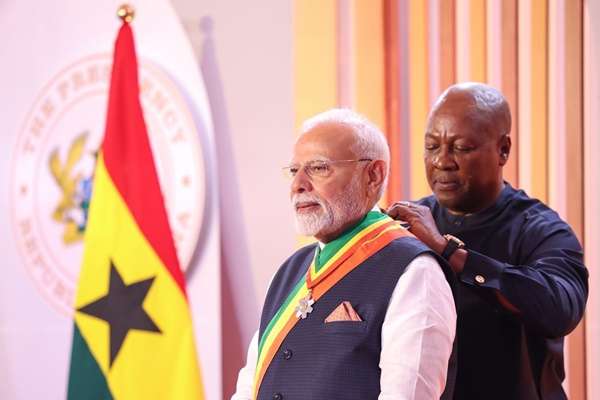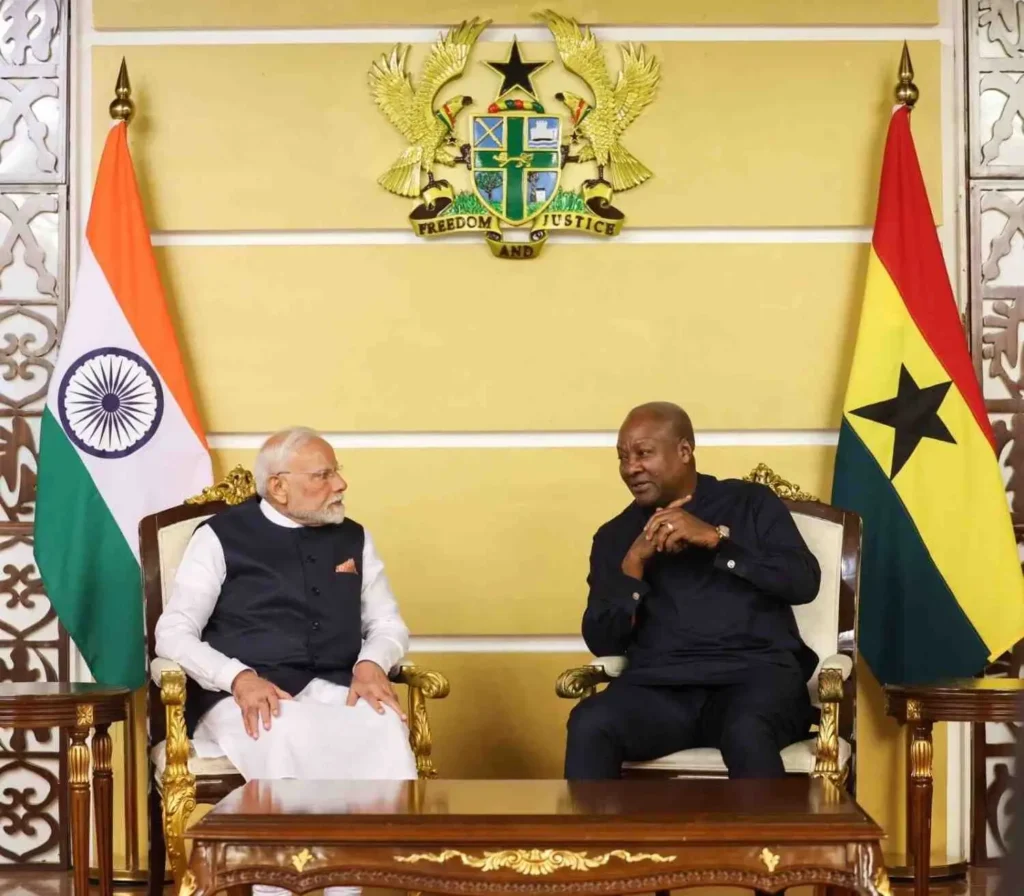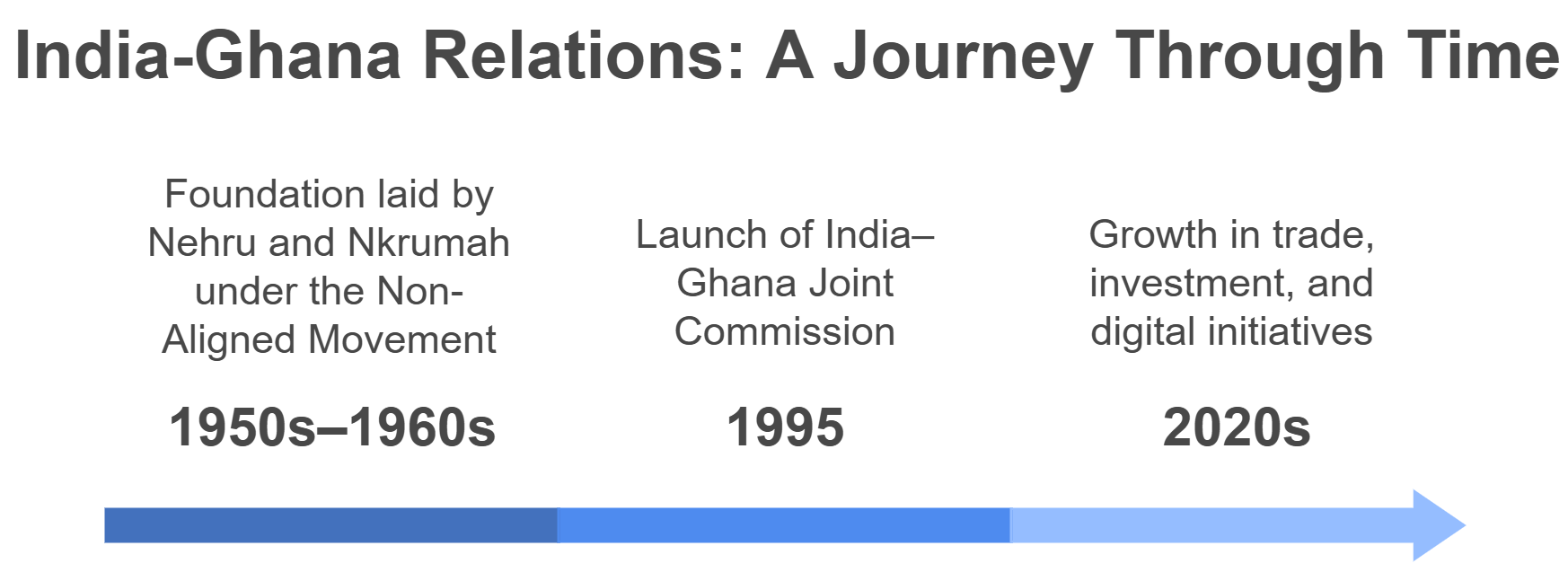Prime Minister Narendra Modi Ghana visit has signalled a watershed moment in India-Africa strategic engagement. On July 2, 2025, Prime Minister Narendra Modi arrived in Ghana is the only Indian Prime Minister to visit Ghana in more than 30 years. Prime Minister Modi entered Ghana with symbolic goodwill. The presidential guard of honour and personal welcome by President John Dramani Mahama helped signify Ghana’s extraordinary respect for India. In addition, the reception from the Indian diaspora in Ghana indicates the socio-cultural proximity and India’s soft power presence.
Deep-Rooted India Ghana Relationship
The seeds of the India-Ghana Relationship were there in the 1950s with Jawaharlal Nehru and Kwame Nkrumah promoting non-alignment and South-South Cooperation. India opened a non-resident mission in Accra long before Ghana’s independence in 1957, and established full diplomatic relations, also in 1957. Over the decades India has supported Ghana with concessional lines of credit for railway, electrification, and telecommunication projects, the Ghana-India Kofi Anan Centre of Excellence in ICT, and the training of over 1,100 Ghanian students and professionals under ITEC.
The Officer of the Order of the Star of Ghana
In a historic move, President Mahama presented PM Modi “The Officer of the Order of the Star of Ghana”, Ghana’s highest civilian award, citing his exemplary contribution to global statesmanship in a leadership position. This award has been awarded to other global figures like Nelson Mandela, Kofi Annan, King Mohammed VI, and Queen Elizabeth II. Accepting the award, Modi dedicated it to the youth of India, its diversity of cultures and shared histories with Ghana, and committed to further strengthen and action the bilateral relationship.

Elevating a Comprehensive Partnership
In their delegation-level discussion, both leaders agreed to elevate India-Ghana ties to a “Comprehensive Partnership” a signal of deepened collaboration beyond diplomacy.
- Trade & Investment: Bilateral trade has already crossed US $3 billion, driven by around US $2 billion in Indian investment across 900 projects. The target is to double trade within five years.
- Critical Minerals: India will partner with Ghana in exploration and mining of critical minerals vital for clean energy, aligning with both countries’ industrial strategies.
- Digital Infrastructure: Ghana will benefit from India’s Bharat UPI experience as part of its digital finance rollout, supporting Ghana’s fintech ecosystem.
- Defence & Security: India and Ghana pledged deeper military cooperation across armed forces training, maritime security, cyber-defence, and defence supply, under “security through solidarity”.
- Counter-Terrorism & Diplomacy: Both nations affirmed that terrorism is “the enemy of humanity” and agreed to co-operate more closely in counter-terrorism and diplomatic initiatives aimed at peace.
MOUs Signed
The visit also witnessed the signing of four significant Memorandums of Understanding:
- Joint Commission Meeting to institutionalize high-level foreign office dialogue.
- Cultural Exchange Programme to boost art, dance, literature, and tourism ties.
- BIS–GSA Collaboration in standardization and quality certification.
- Ayurveda–Traditional Medicine Collaboration between Indian and Ghanaian institutes for education, training, and R&D.
Development Cooperation
Prime Minister Modi announced India’s intention to support Ghana establish a Skill Development Centre and increase ITEC/ICCR scholarships. Additionally, India will share knowledge and best practices to help Ghana’s “Feed Ghana” programme, help promote reliable, affordable healthcare through Jan Aushadhi Centres, and assist in developing manufacturing capabilities for vaccines.
Strategic Context: Countering Geopolitical Rivalry
China remains Ghana’s largest FDI partner (~US$2.2 billion), with investment through projects like Bui Dam. With Prime Minister Modi’s visit and the emphasis on capacity building debt-free, India is offering a different model of development – a balanced, demand-led process aimed at cooperation, not dependence. This is also part of India’s broader Global South strategy as demonstrated by Prime Minister Modi’s visits to multiple Afro-Latin American countries this year, positioning India as a partner for the developing world.
Historical Evolution
- 1950s–1960s: Foundation laid by Nehru and Nkrumah under the Non-Aligned Movement.
- 1995: Launch of India–Ghana Joint Commission to facilitate high-level strategic dialogue.
- 2000s–2010s: Infrastructure projects, ICT centre, scholar and technical exchanges.
- 2020s: Growth in trade (US $3.3 billion by 2024–25), investment (~US $2 billion), and digital initiatives like e-VBAB.
Conclusion
The recent visit of Prime Minister Narendra Modi to Ghana offers more than a diplomatic protocol, it offers a strategic engagement symbolizing equality, capacity building, and respect. As India expands its presence in Africa, the India-Ghana model offers something novel: economic empowerment, defence cooperation, digital inclusion, health care collaboration, and cultural exchange, which build on shared colonial histories and values of democracy. Ghana’s embrace of India’s partnership, and suspicion of traditional debt-based modalities, illustrates the growth of India’s influence across the Global South. With similar partnerships developing in showcase of other African states, India is providing an opportunity and creating a path grounded in mutual empowerment – not dependency, one in which India and Africa will be growing together, and stronger every day.
Frequently Asked Questions:
-
Why is PM Modi’s visit to Ghana significant?
It’s the first by an Indian PM in over 30 years and signals a strategic upgrade in India-Africa relations, with major cooperation initiatives. -
What sectors are India and Ghana focusing on?
Key areas include trade, digital infrastructure, critical minerals, defence, traditional medicine, and skill development. -
How does India’s approach differ from China’s in Ghana?
India promotes a debt-free, demand-led model focused on capacity building, contrasting China’s high-debt infrastructure investments.


